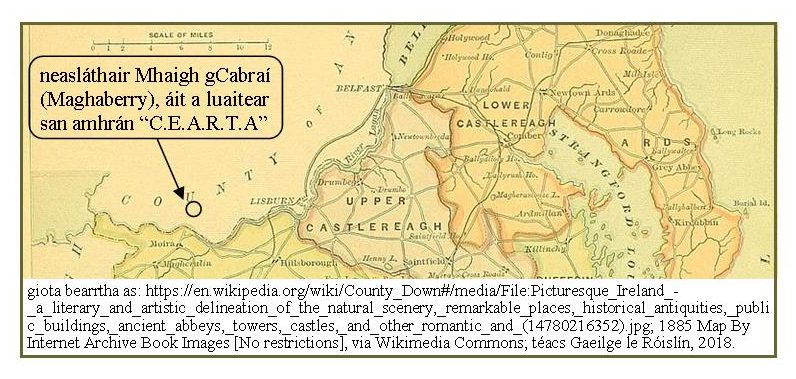A Short Glossary for the Irish Rap Song “C.E.A.R.T.A” by Kneecap (Rapcheol Gaeilge) [Cuid/Pt.2] Posted by róislín on Jan 11, 2018 in Irish Language
(le Róislín)
“Yoke” might traditionally mean a wooden bar fastened across the necks of two plough animals, like oxen, but in the Irish (Hiberno-English) context, it has a completely different meaning. And the subject of today’s blogpost, the Irish language rap song “C.E.A.R.T.A” by Kneecap, gives it yet another angle, which I’ll let you figure out as you check out the lyrics (nasc thíos do na liricí agus don bhfís YouTube). At any rate, the song is definitely not referring to a “cuing,” which is a “yoke” as an agricultural implement. This post is a continuation of the glossary started last time (nasc thíos), mostly looking at some of the Irish words in the song, including a place name (na focail i nGaeilge, logainm ina measc), but also dealing a bit with an English-language idiom used in Ireland (“yoke”). If you’re still wondering about the usual meaning of “yoke” in Hiberno-English, bhuel, bíodh foighne ort. Tá an chiall sa ghluais thíos.Before we start, though, we’ll recap (hey – that’s one of the few words ever that rhyme with “kneecap”!) a few points from last time. The first is a point regarding the pronunciation of the spelled-out letters of the song title, “C.E.A.R.T.A.” For Americans, who usually pronounce the letter “A” in the alphabet as “ay” (rhyming with “hay” or “may” or Irish “é”), please remember that when the letters C-E-A-R-T-A are sung in this song, the “A” is pronounced more like “ah,” so the final “A” rhymes roughly with the final “a” of “garda” in the following line. Second, and it’s just the “eagarthóir cáiréiseach” in me, I just want to note that I’ve added stanza numbers here to make it easier to find the glossed words. If you’re looking for the lyrics, I’m not including them right in this post, for copyright reasons, but they’re easy enough to find in the link below.
And here’s the glossary, second installment:
Véarsa 3: yoke, an Irish-English placeholder noun, meaning “thing,” “gadget,” “device,” or anything that you can’t think of the name of. Some typical equivalent Americanisms are “thingy,” “thingumabob,” etc., although the usage of “yoke” in this song is a little more edgy (that’s the part for you to determine for yourself). BTW, for a placeholder noun in Irish, you can either say, quite straightforwardly, “an rud sin” or “an rud úd” or “an boc sin,” or, if you want to say “Mr. Thingumbob” or “Mr. So-and-So,” you can say “Mac Uí Rudaí” or “Mac Uí Rudaigh” lit. something like “Son of O’Thing.” But the Irish expressions wouldn’t have fit the song’s rhyme scheme and meter.
Véarsa 4: i bhfaitiú na súl – in the blink of an eye (I learned the spelling “i bhfaiteadh na súl” for this, but so be it.). And just to recap the forms of the Irish word for “eye,” which are a bit tricky, they are:
súil, an eye (also means “hope” or “expectation” but that’s beyond our focus here)
an tsúil, the eye
súile, of an eye (mogall súile, an eyelid, lit. a mesh, husk, or globular mass of an eye)
na súile, of the eye (dath na súile, the color of the eye, in case you’re talking about Polaiféamas, an Chioclóp; normally we say, “dath na súl, the color of the eyes)
na súile, the eyes (as in phrases like: súile gorma, súile donna, srl.)
súl, of eyes (braonta súl, eyedrops)
na súl, of the eyes (i bhfaiteadh na súl, in the twinkling of the eyes – in Irish the eyes are plural for this expression; in English, it’s singular, at least in my experience: in the twinkling of an eye)
Véarsa 4: Maghaberry (Maigh gCabraí), a village (sráidbhaile) and townland (baile fearainn) in Co. Antrim (Contae Aontroma) and the site of a high security prison. “Maghaberry” is pronounced with stress on the “ghab” syllable, presumably suggesting that the “gCab-” syllable in Irish is the most stressed syllable in the word (based on the recording at https://www.logainm.ie/ga/1166445). The map in the graphic above shows the approximate location (an neasláthair), very near the border with Co. Down (an-ghar don teorainn le Contae an Dúin).
Véarsa 4: ar mo thóin, I doubt I need to translate this for anyone. There are plenty examples of it online, if you do need it, ranging from a phrase for literally “backing out of something” (dul ar do thóin / ar a thóin / ar a tóin, srl.) to the idea of “following close behind” (“sa tóir ar mo thóin,” as the song says)
Bhuel, sin dhá véarsa eile, and it looks like we’ll have at least two more posts before the glossary for the song is done. Hope this is helping with understanding the nuances of the lyrics, especially for anyone who’s not from Northern Ireland. SGF – Róislín
P.S. Cén fáth nár úsáid mé mapa nua de cheantar Mhaigh gCabraí? Cóipcheart. Ní raibh mé ábalta teacht ar mhapa nua den cheantar atá san fhearann poiblí. Má tá aon nasc agat do mhapa den cheantar sin atá san fhearann poiblí, bheinn breá sásta an ghrafaic a athrú.
Naisc:
nasc d’fhís den amhrán: Kneecap “C.E.A.R.T.A” https://www.youtube.com/watch?v=8Sf0htzbMKk
nasc do na liricí: https://nos.ie/cultur/ceol/amhran-na-haoine-cearta-kneecap/ Foireann NÓS 15ú Nollaig 2017 CEOL#amhrán aoine Amhrán na hAoine ‘C.E.A.R.T.A.’, le Kneecap
Cuid a hAon den ghluais: A Short Glossary for the Irish Rap Song “C.E.A.R.T.A” by Kneecap (Rapcheol Gaeilge) [Cuid/Pt.1]Posted by róislín on Jan 7, 2018 in Irish Language

Build vocabulary, practice pronunciation, and more with Transparent Language Online. Available anytime, anywhere, on any device.





Leave a comment: